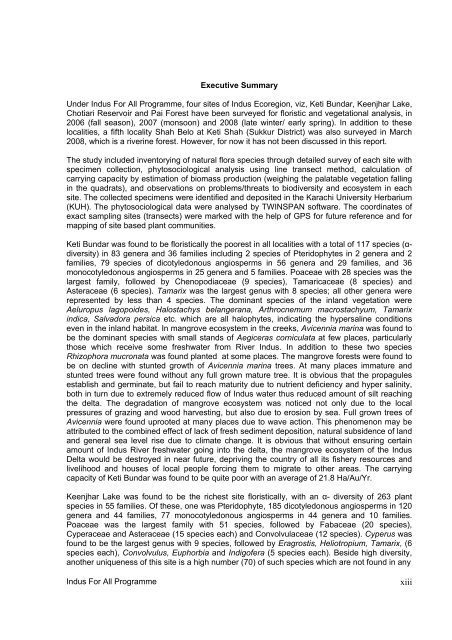Download - foreverindus.org - WWF - Pakistan
Download - foreverindus.org - WWF - Pakistan
Download - foreverindus.org - WWF - Pakistan
You also want an ePaper? Increase the reach of your titles
YUMPU automatically turns print PDFs into web optimized ePapers that Google loves.
Indus For All Programme<br />
Executive Summary<br />
Under Indus For All Programme, four sites of Indus Ecoregion, viz, Keti Bundar, Keenjhar Lake,<br />
Chotiari Reservoir and Pai Forest have been surveyed for floristic and vegetational analysis, in<br />
2006 (fall season), 2007 (monsoon) and 2008 (late winter/ early spring). In addition to these<br />
localities, a fifth locality Shah Belo at Keti Shah (Sukkur District) was also surveyed in March<br />
2008, which is a riverine forest. However, for now it has not been discussed in this report.<br />
The study included inventorying of natural flora species through detailed survey of each site with<br />
specimen collection, phytosociological analysis using line transect method, calculation of<br />
carrying capacity by estimation of biomass production (weighing the palatable vegetation falling<br />
in the quadrats), and observations on problems/threats to biodiversity and ecosystem in each<br />
site. The collected specimens were identified and deposited in the Karachi University Herbarium<br />
(KUH). The phytosociological data were analysed by TWINSPAN software. The coordinates of<br />
exact sampling sites (transects) were marked with the help of GPS for future reference and for<br />
mapping of site based plant communities.<br />
Keti Bundar was found to be floristically the poorest in all localities with a total of 117 species (α-<br />
diversity) in 83 genera and 36 families including 2 species of Pteridophytes in 2 genera and 2<br />
families, 79 species of dicotyledonous angiosperms in 56 genera and 29 families, and 36<br />
monocotyledonous angiosperms in 25 genera and 5 families. Poaceae with 28 species was the<br />
largest family, followed by Chenopodiaceae (9 species), Tamaricaceae (8 species) and<br />
Asteraceae (6 species). Tamarix was the largest genus with 8 species; all other genera were<br />
represented by less than 4 species. The dominant species of the inland vegetation were<br />
Aeluropus lagopoides, Halostachys belangerana, Arthrocnemum macrostachyum, Tamarix<br />
indica, Salvadora persica etc. which are all halophytes, indicating the hypersaline conditions<br />
even in the inland habitat. In mangrove ecosystem in the creeks, Avicennia marina was found to<br />
be the dominant species with small stands of Aegiceras corniculata at few places, particularly<br />
those which receive some freshwater from River Indus. In addition to these two species<br />
Rhizophora mucronata was found planted at some places. The mangrove forests were found to<br />
be on decline with stunted growth of Avicennia marina trees. At many places immature and<br />
stunted trees were found without any full grown mature tree. It is obvious that the propagules<br />
establish and germinate, but fail to reach maturity due to nutrient deficiency and hyper salinity,<br />
both in turn due to extremely reduced flow of Indus water thus reduced amount of silt reaching<br />
the delta. The degradation of mangrove ecosystem was noticed not only due to the local<br />
pressures of grazing and wood harvesting, but also due to erosion by sea. Full grown trees of<br />
Avicennia were found uprooted at many places due to wave action. This phenomenon may be<br />
attributed to the combined effect of lack of fresh sediment deposition, natural subsidence of land<br />
and general sea level rise due to climate change. It is obvious that without ensuring certain<br />
amount of Indus River freshwater going into the delta, the mangrove ecosystem of the Indus<br />
Delta would be destroyed in near future, depriving the country of all its fishery resources and<br />
livelihood and houses of local people forcing them to migrate to other areas. The carrying<br />
capacity of Keti Bundar was found to be quite poor with an average of 21.8 Ha/Au/Yr.<br />
Keenjhar Lake was found to be the richest site floristically, with an α- diversity of 263 plant<br />
species in 55 families. Of these, one was Pteridophyte, 185 dicotyledonous angiosperms in 120<br />
genera and 44 families, 77 monocotyledonous angiosperms in 44 genera and 10 families.<br />
Poaceae was the largest family with 51 species, followed by Fabaceae (20 species),<br />
Cyperaceae and Asteraceae (15 species each) and Convolvulaceae (12 species). Cyperus was<br />
found to be the largest genus with 9 species, followed by Eragrostis, Heliotropium, Tamarix, (6<br />
species each), Convolvulus, Euphorbia and Indigofera (5 species each). Beside high diversity,<br />
another uniqueness of this site is a high number (70) of such species which are not found in any<br />
xiii
















